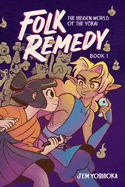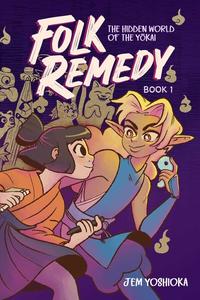
 Japanese New Zealander comics artist Jem Yoshioka makes her middle-grade debut with the first book in the Folk Remedy series, an exhilarating, other-worldly adventure centering family legacy, loyalty, and friendship. Takeyama, "a sleepy town in the countryside," is home to Morimura's Apothecary. Their telephone is still quite new, a modern convenience young Maple appreciates, but her mother insists it's "a kitsune trick": "How can we trust it's really a human on the other end?" Mother reminds Maple that kitsune and all yōkai (supernatural creatures) are real, and "are to be respected." With a dismissive "yeah, yeah," Maple leaves to make the afternoon deliveries, then visits her friend Kunio. "No one in Taishō City believes in any of this country yōkai stuff," he agrees.
Japanese New Zealander comics artist Jem Yoshioka makes her middle-grade debut with the first book in the Folk Remedy series, an exhilarating, other-worldly adventure centering family legacy, loyalty, and friendship. Takeyama, "a sleepy town in the countryside," is home to Morimura's Apothecary. Their telephone is still quite new, a modern convenience young Maple appreciates, but her mother insists it's "a kitsune trick": "How can we trust it's really a human on the other end?" Mother reminds Maple that kitsune and all yōkai (supernatural creatures) are real, and "are to be respected." With a dismissive "yeah, yeah," Maple leaves to make the afternoon deliveries, then visits her friend Kunio. "No one in Taishō City believes in any of this country yōkai stuff," he agrees.
Back at home, Maple tries again to convince Mother "the world is changing. We don't need those old [yōkai] stories anymore. We have technology! Electricity! Trains!" But Mother decides it's time to teach Maple the family's apothecary heritage: "We learned from yōkai." Presenting the venerable yōkai tome, Mother explains, "every generation for the past 500 years has used this book to share their yōkai stories... we inherit the book, we learn from it... and we record our own experiences in it... so that the next generation can also learn." Along with the book, Mother reveals that their lantern holds a yōkai who has been trapped inside for 300 years. Unconvinced, Maple decides the lantern can substantiate her doubts: if "no yōkai comes out, I'll have proven to Mother that they don't exist." Except Ember emerges, angry and ready to leave. Ember wants to go home, but only their magatama--an enchanted carved stone--can get them there. Unfortunately, Maple gave the stone to Kunio. Yōkai and human head to Taishō City to retrieve it, but their journey won't be easy, as they confront shape-shifting tanuki, mischievous tengu, and monstrous oni.
Maple--her expressions, her humor, her tenacity--entertainingly dominates Yoshioka's lively panels as she struggles between centuries-old tradition and quickly changing modernity. Yoshioka varies her color palettes accordingly, reserving predominantly earth tones for Mother's world and the apothecary, relying on purples, pinks, and blues for glimpses of other realms, brightening and heightening the saturation the further Maple travels from home. Folk Remedy relies on yōkai from Japanese folklore and mythology but Yoshioka adds "a few new inventions" to create her own realm. The final page turn is exactly the kind of cliffhanger that will have audiences clamoring for Book Two. --Terry Hong
Shelf Talker: Jem Yoshioka introduces lively young Maple, whose disbelief in yōkai gets inventively, entertainingly debunked when she releases Ember from 300 years of entrapment.

